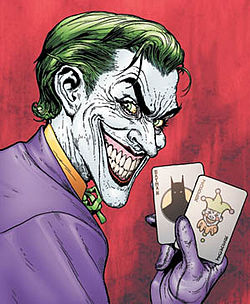The Joker takes many forms and shapes. Evil is a slippery business.
Let's briefly consider two jokers. The first is familiar from Batman and might be described as
the Clown Prince of Crime (or Chaos),
the Harlequin of Hate (Havoc),the Ace of Knaves
In combat he deploys poisons and explosives as well as comic weapons such as bladed playing cards. In many cases his victims die laughing, as a result of his Joker Venom
"a deadly poison that infects his victims with a ghoulish rictus grin as they die while laughing uncontrollably."
(The risus sardonicus is a sustained involuntary facial grin possibly caused by tetanus or strychnine.)
The other joker, and origin for the one familiar from Batman, is L'homme Qui Rit
(The Man Who Laughs, 1869) a novel by Victor Hugo, and a film of 1928.
The monster protagonist Gwynplaine has been disfigured in infancy by the comprachicos (child buyers/traders)
Let's end the blog with an image from the book and a quotation describing Gwynplaine
L'Homme Qui Rit.
BOOK THE SECOND. CHAPTER I.
WHEREIN WE SEE THE FACE OF HIM OF WHOM WE HAVE HITHERTO SEEN ONLY THE ACTS.
Nature had been prodigal of her kindness to Gwynplaine. She had bestowed on him a mouth opening to his ears, ears folding over to his eyes, a shapeless nose to support the spectacles of the grimace maker, and a face that no one could look upon without laughing.
We have just said that nature had loaded Gwynplaine with her gifts. But was it nature? Had she not been assisted?
Two slits for eyes, a hiatus for a mouth, a snub protuberance with two holes for nostrils, a flattened face, all having for the result an appearance of laughter; it is certain that nature never produces such perfection single-handed.
But is laughter a synonym of joy?
If, in the presence of this mountebank—for he was one—the first impression of gaiety wore off, and the man were observed with attention, traces of art were to be recognised. Such a face could never have been created by chance, it must have resulted from intention. Such perfect completeness is not in nature. Man can do nothing to create beauty, but everything to produce ugliness. A Hottentot profile cannot be changed into a Roman outline, but out of a Grecian nose you may make a Calmuck's. It only requires to obliterate the root of the nose, and to flatten the nostrils. The dog Latin of the middle ages had a reason for its creation of the verb denasare. Had Gwynplaine when a child been so worthy of attention that his face had been subjected to transmutation? Why not? Needed there a greater motive than the speculation of his future exhibition? According to all appearance, industrious manipulators of children had worked upon t his face. It seemed evident that a mysterious and probably occult science, which was to surgery what alchemy was to chemistry had chiseled his flesh, evidently at a very tender age, and manufactured his countenance with premeditation. That science, clever with the knife, skilled in obtusions and ligatures, had enlarged the mouth, cut away the lips, laid bare the gums, distended the ears, cut the cartilages, displaced the eyelids and the cheeks, enlarged the zygomatic muscle, pressed the scars and cicatrices to a level, turned back the skin over the lesions whilst the face was thus stretched, from all which resulted that powerful and profound piece of sculpture, the mask, Gwynplaine.
Ian McCormick's Blog No. 23
Dr Ian McCormick is the author of The Art of Connection: the Social Life of Sentences
(Quibble Academic, 2013)
Dr Ian McCormick is the author of The Art of Connection: the Social Life of Sentences
(Quibble Academic, 2013)


The Joker: The only sensible way to live in this world is without rules!
ReplyDeleteThe Joker: See, I'm not a monster...I'm just ahead of the curve.
Why not follow new blog posts on monsters and the grotesque on Twitter - link to "PostFilm" ?
ReplyDelete